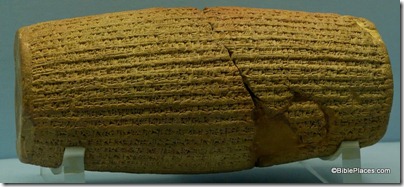The BBC reports that the Cyrus Cylinder is on a four-month loan to the museum in Tehran. The British Museum had previously agreed to loan the artifact but delays led the Iranian museum to warn it would cut all ties with the British Museum.
The Cyrus Cylinder is well known because it describes practices of the Persian king (ruled 559-530 BC) similar to that described in the Bible.
I returned the (images of) the gods to the sacred centers [on the other side of] the Tigris whose sanctuaries had been abandoned for a long time, and I let them dwell in eternal abodes. I gathered all their inhabitants and returned (to them) their dwellings (Context of Scripture 2: 315).
As predicted by Isaiah, the Israelites were allowed to return to their land under Cyrus. This is reported in the last two verses of 2 Chronicles and the beginning of Ezra.
Ezra 1:1–4 (NIV) In the first year of Cyrus king of Persia, in order to fulfill the word of the Lord spoken by Jeremiah, the Lord moved the heart of Cyrus king of Persia to make a proclamation throughout his realm and to put it in writing: 2 “This is what Cyrus king of Persia says: “ ‘The Lord, the God of heaven, has given me all the kingdoms of the earth and he has appointed me to build a temple for him at Jerusalem in Judah. 3 Anyone of his people among you—may his God be with him, and let him go up to Jerusalem in Judah and build the temple of the Lord, the God of Israel, the God who is in Jerusalem. 4 And the people of any place where survivors may now be living are to provide him with silver and gold, with goods and livestock, and with freewill offerings for the temple of God in Jerusalem.’”
The Cyrus Cylinder is in my “top 15” list of artifacts in the British Museum.
